I have a bit of a love/hate relationship with my Icom IC-7000. I think that it’s a fantastic radio, with a ton of stuff packed into a very small size. My radio has suffered several failures over its life and has let me down at critical moments. I want to document the most recent failure for posterity, which happens below, but first I’ll cover the background. If you are not interested, skip the history and go straight to where I describe the latest failure and my analysis.
Background
In my early SOTA days, I was hauling it up to mountain peaks with me and operating in all kinds of conditions. I’ve also used it at home, for field day, and in the back country for heavy digital modes like Pactor-3 during events, most of the time with less-than-ideal makeshift antennas. It has definitely seen a lot of action, and has lived life far from the safe environment of an indoor ham shack’s desk top. I think that it packs an incredible amount of functionality and performance into a very small package, and it was definitely a front-runner in that category. That may be why it seems to have a somewhat poor reputation for being prone to failure. I don’t really fault the radio for punching above its weight class, or Icom for pushing the envelope. Like a specialty sports car, you buy it for the performance, not the reliability. In reality, if this thing died, I don’t really know what I’d replace it with; there’s really no equivalent offering today, in my opinion.
The first major issue happened while I was using it in the backcountry to provide Winlink messaging for an event, about 2012 or so. Occasionally, the radio would just go “deaf” on HF for several minutes at a time. It would be sitting there in receive mode showing background band noise (or actual signals) and then suddenly show a zero S-meter and no noise (other than internal receiver noise) for several minutes. This would persist across all bands. Then as suddenly as it went away, the receiver would come back and it would work fine for a while…until it wouldn’t again. For this, it went back to Icom, along with a detailed description of the problem and a video showing the symptoms over the course of several hours and several such events. Unfortunately, the usually-stellar Icom service center let me down on this also. They refused to watch the video and claimed that they were unable to reproduce the problem (I’m guessing because they only tested for a few minutes). They re-seated the ill-fated ribbon cables in the radio, and sent it back to me with a bill for their troubles. They also tried to argue that what I described was my own ignorance and that obviously I had some noise source in the house that was coming and going, despite the problem first manifesting hundreds of miles away, and persisting across all bands simultaneously. But alas. In general Icom service has been great and has a good reputation for being so. Despite my poor experience with one technician, I’m still an Icom fanboy.
When the radio came back from Icom, it went straight on the shelf. They couldn’t reproduce the problem, which means I couldn’t trust it. I was disappointed and frustrated with the service center, so I just moved on. At that point, I was using my Elecraft KX3 for SOTA stuff, which is, perhaps, the perfect radio for it. The IC-7000 stayed on the shelf for probably two years until I decided to get it out to play in a contest. When I tried to power it on, I got the “click-click of death” behavior. The radio wouldn’t power on, and just energized and then de-energized the internal relay when I pushed the power button. I was shocked, because I literally hadn’t powered it back on since Icom returned it to me and it seemed like they sent it back in worse shape. I tracked this down to a shorted tantalum capacitor in the head, which is a semi-well-known failure in these radios. It doesn’t seem like that would have happened while sitting on a shelf without any power for two years, but I’m not sure. I made that repair and the radio came back to life again. I still didn’t trust it, so it went back on the shelf for a couple more years.
This past year, I did field day for the first time in a while and had a blast. I wanted to use the IC-7000, but didn’t trust it so I used my IC-7200 (which is also a fantastic radio, but not really well-suited for contests). After field day, I decided to get the IC-7000 out and work some HF from home in order to put it through its paces. It held strong for hours of full-power SSB QSOs and I was starting to think that it had been exorcised of its demons. That is, until they popped out again.
The latest failure
At one point while transmitting, the radio shut off and then rebooted. Each time I would transmit, it would shut off, and then it got stuck in some sort of loop. Whenever power was applied to the DC jack, the radio would sit in what seemed like a tight reboot loop of just clicking the relay on and off (it was so fast that the screen never had a chance to come on). I took a break, let the radio sit for a while without power, and when I came back, it powered on and continued to work for some time after that. However, it was short-lived and at one point it shut off while transmitting for what would be the last time. The radio was stone dead, showing no signs of life. No relay clicking, no speaker popping, no significant power draw when plugged in, just … nothing.
Being totally not incentivized to spend more money and frustration with the Icom service center, I decided to take another shot at diagnosing the problem. The shorted capacitor in the head had been self-resolvable, after all. I found some information about the power up process that the radio goes through, which was helpful in catching a lead to the actual fault. At all times when the radio has power, the “logic unit” (i.e. the CPU module) receives the 14v input voltage through the HV line. This powers a 3.3v regulator on the logic unit itself, which powers the CPU. There is a pull-up resistor that brings the PWRK line high to the 3.3v rail from the regulator, which goes to the control head. To power the radio on, the control head brings the PWRK line to ground, which the CPU notices, and powers on the rest of the radio by energizing the main relay through a driver transistor.
Checking the PWRK signal on the head connector (pin 2), I saw that it was at about 2.0v, well below the expected 3.3v. Pulling the cover off of the logic unit, I checked the regulator and found that not only was the output low (about 2.4v right at the regulator), but the input was also about 2.7v instead of the expected 14v from the supply.
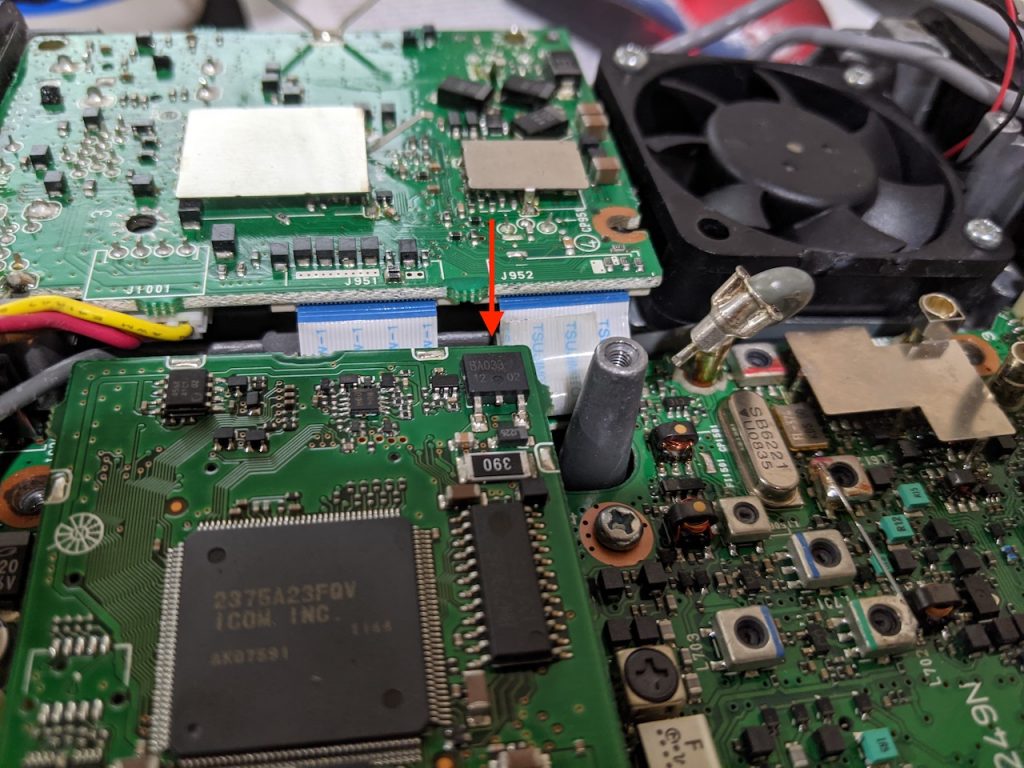
My thought was that, like the previous capacitor failure in the head, I was looking for something that is now shorted to ground, either on the high or low side of the regulator. Checking a bunch of the bypass caps on both sides, I found none that seemed to be problematic, so I thought maybe the regulator itself was faulty. I removed it (in pieces, unfortunately) and as soon as I did, the input pad was reading 14v from the supply again.
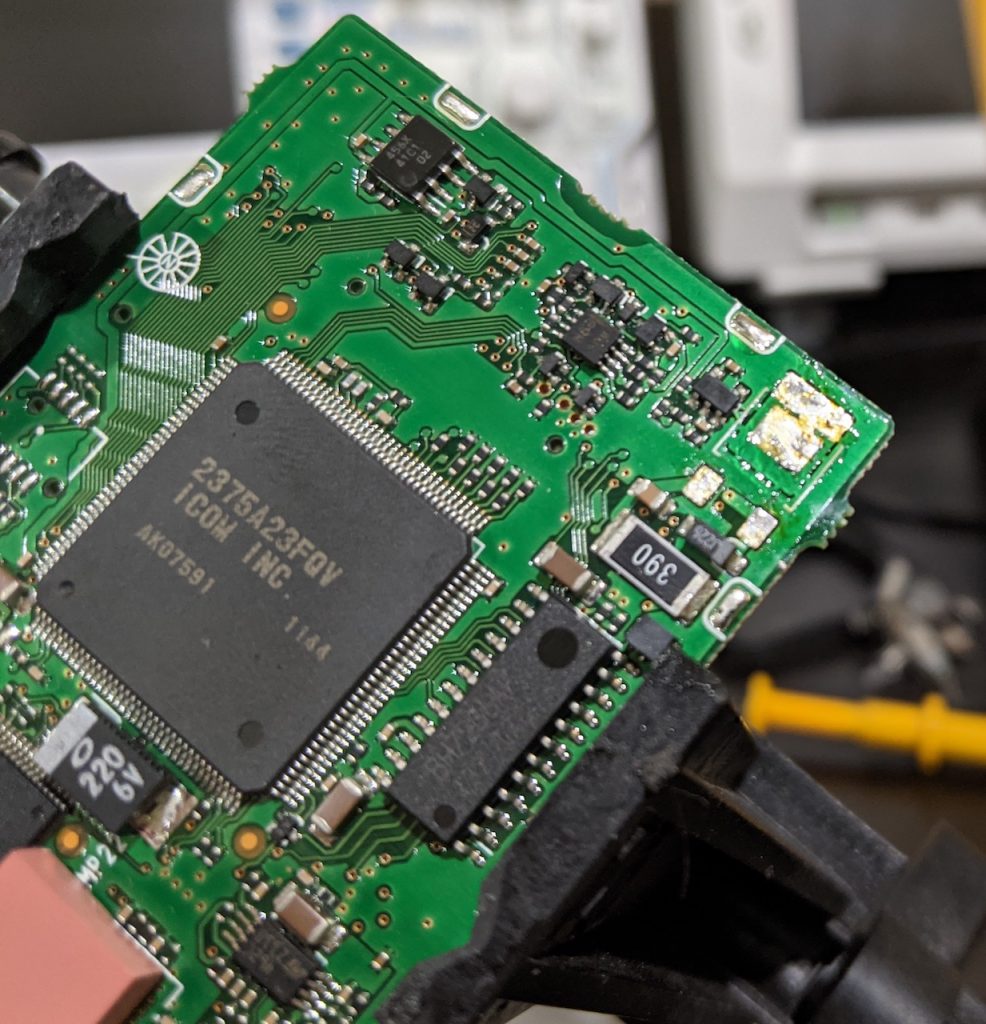
I thought I was in good shape, so I temporarily soldered a TO-220 3.3v regulator I had in my stash to see if that would solve the problem. Unfortunately, it did the exact same thing, showing the same low input and output voltages.
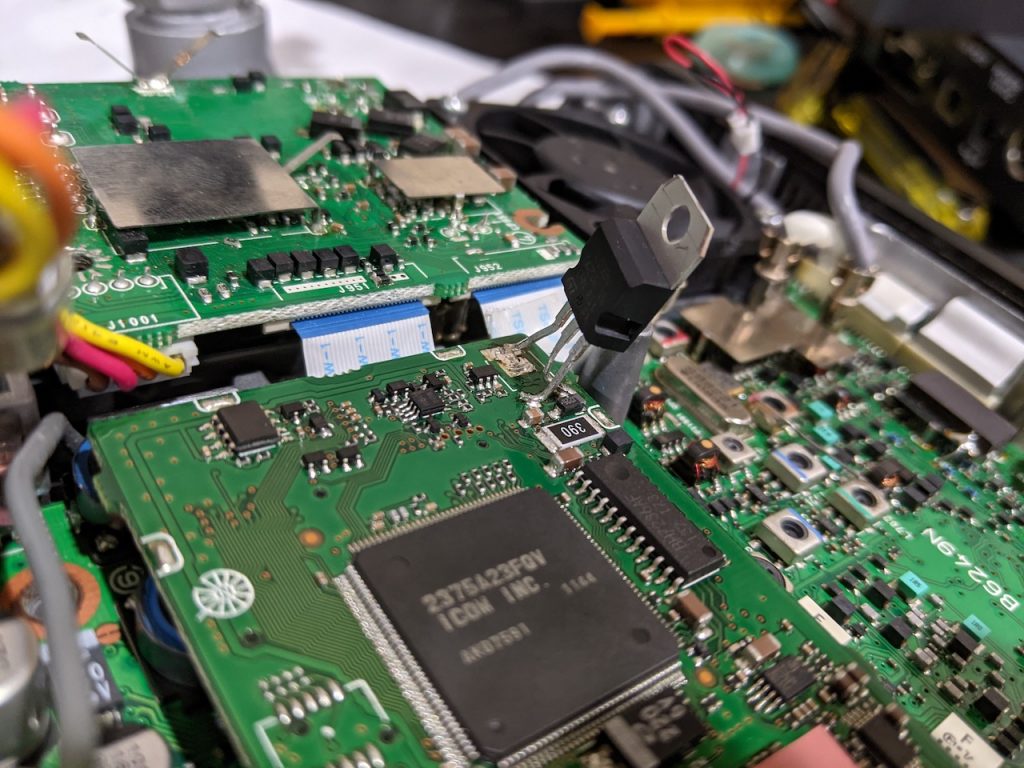
Still on the path of expecting something was dragging either the input or output to ground, I decided to try to isolate the logic unit from the main unit, to see whether the fault was on one or the other. I powered the logic module while disconnected from the main unit by feeding the regulator’s input directly. Sure enough, the output held at the expected 3.3v, with no voltage drop on the input side. This, I figured, meant something on the main unit was shorted. I put the logic unit back into the main unit, and again fed the logic regulator directly, expecting to see the output be pulled down. However, even seated in the main unit, the regulator behaved properly: no voltage sag on either the input or output.
At this point, I took a break, assuming the fault was in one of the main ICs, like perhaps the CPU itself and that I’d be looking at a more substantial replacement of that entire module, or worse. But, then I had the thought that if we’re really dragging the 14v from the supply down to ~3v, we would have to be pulling a lot of current through something and things should be smoking (and they weren’t). Further, the PWRK line was available on the outside of the radio, which means it really needed to be protected from over-current if something contacted the exposed pins while power was applied.
So, I started tracing the HV line to its source. The logic unit gets it from the main unit, which basically passes it straight through from the PA unit, which is where the DC supply connects to the radio. Here, the HV line is fed from the DC supply through the c line of Bus Line 1, through an RF choke (EP703) and a 4.7 ohm resistor (R723).
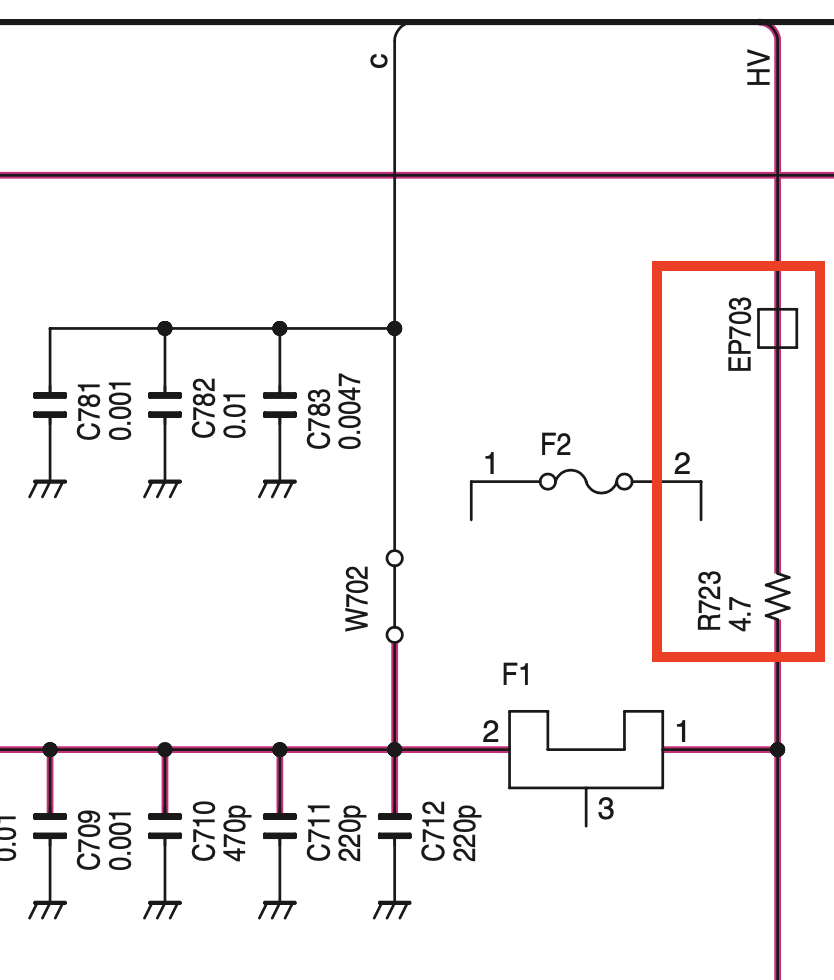
This, I assume, is the current-limiting resistor to prevent that always-on HV line from smoking a trace if it contacts ground. So, I found those two components on the PA board to measure them, and luckily found them on the bottom (exposed) surface by the front-loading fuse holder. The choke read zero ohms as expected, but R723 measured (in-circuit) at 52 ohms!
The thinking here is that R723 failed and is showing much higher resistance than expected. Under no load (with the logic unit disconnected), of course the HV line reads full voltage. When applied to the regulator and CPU on the logic unit, the input voltage drops too low to start the CPU and thus no response to the power button input. It’s also possible that the CPU is running, but when the power button is pressed, the low voltage and near zero current provided to the relay gives the impression that nothing is happening.
Again looking to actually solve the problem before I make a Digi-Key order, I bypassed R723 with the lowest value resistor I had on hand, which is 10 ohm. Sure enough, the radio responded to the button stimulus and powered right up!
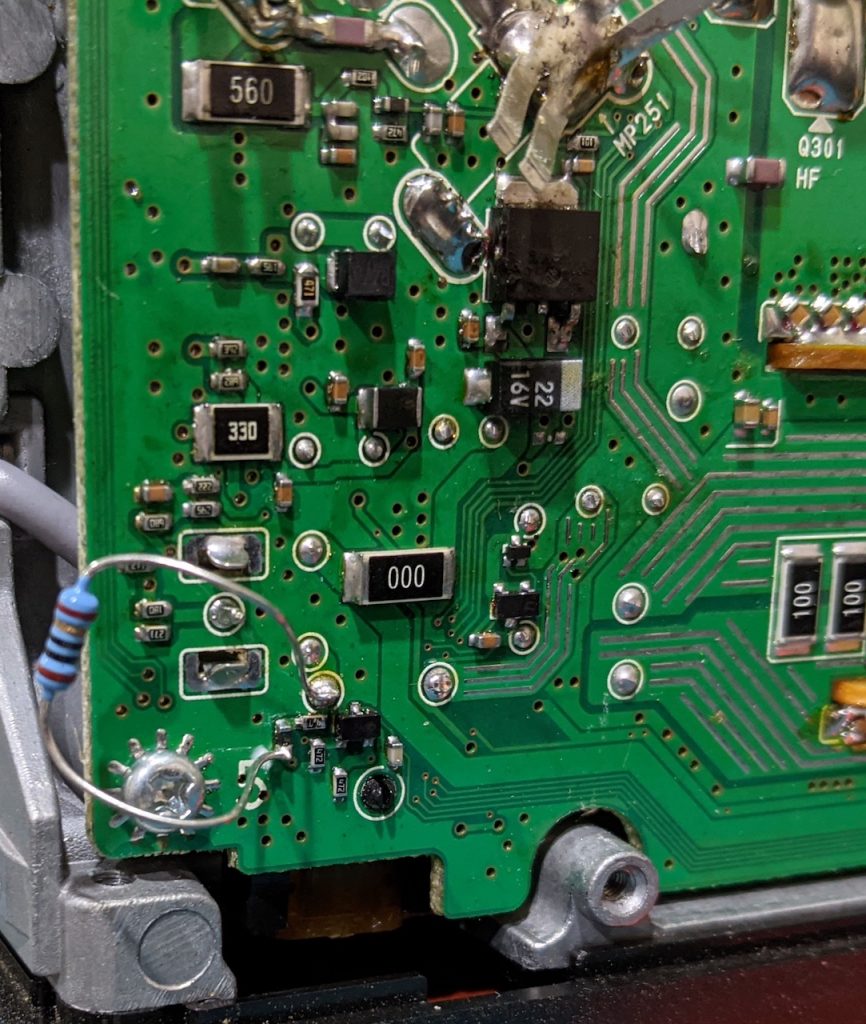
At this point, I think I’ve resolved this latest failure. I’ve got to replace the regulator I removed (in pieces), which will be easy. Far more difficult will be replacing R723, which is smaller than a pin head. Shown here by the red arrow, pencil eraser for scale:
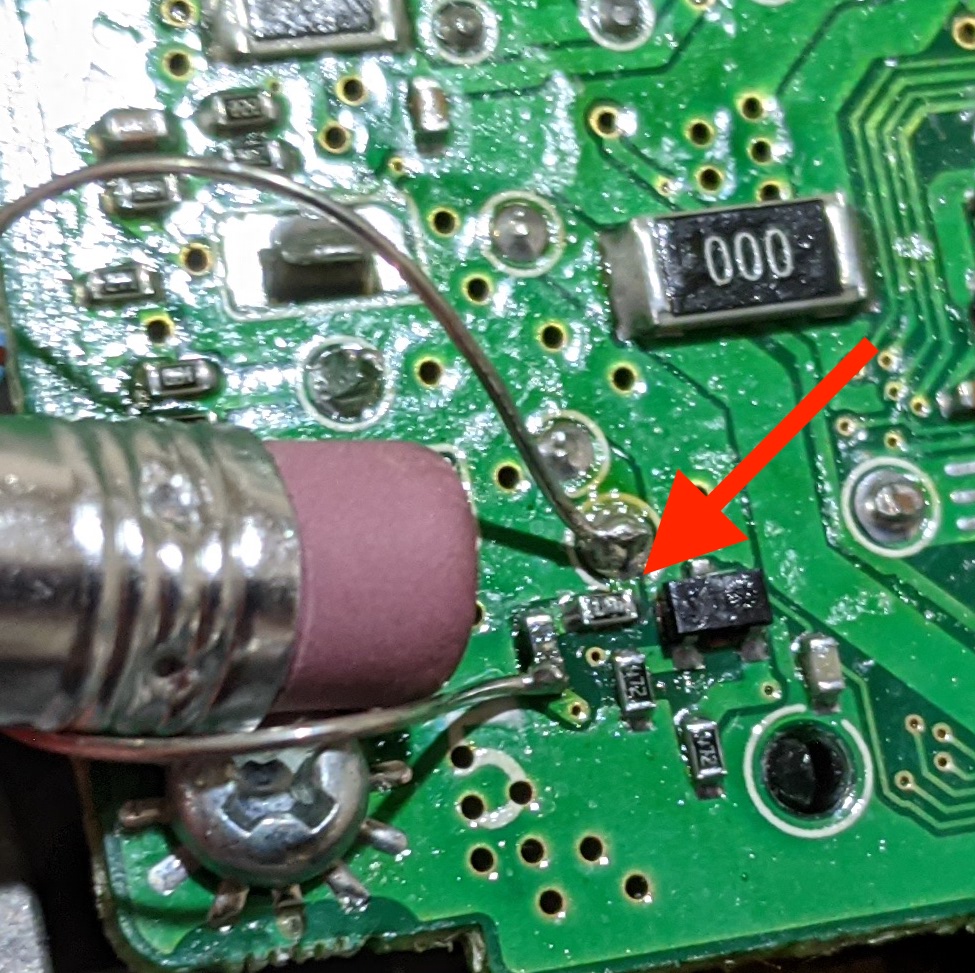
If that doesn’t go well, I may just formalize my bypass resistor in the circuit and call it good. I didn’t find any reports “out there” of this exact problem manifestation, so hopefully this write-up will help someone else if they suffer the same problem, or provide clues for a solution.

One Response to Fixing a dead Icom IC-7000
One Response in another blog/article
[…] my Icom IC-7000 died during transmit. The result was a totally-dead appearance, which I resolved as detailed in this recent post. After repairing it with new parts, the radio powers on, but all is not […]